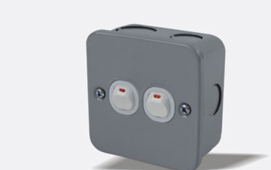Metal clad switches are essential components in electrical systems, widely used in various industries for their safety and reliability. Proper maintenance is crucial to ensure their long - term performance and prevent potential electrical hazards. Here are the key aspects of maintaining metal clad switches properly.

Regular Visual Inspection
The first step in maintaining metal clad switches is to conduct regular visual inspections. Check the exterior of the switch for any signs of physical damage, such as dents, scratches, or corrosion on the metal cladding. A damaged cladding can compromise the switch's protection against electrical shock and environmental factors.
Inspect the connections and terminals. Loose or corroded connections can lead to overheating, arcing, and even electrical fires. Look for any signs of discoloration or charring around the terminals, which may indicate excessive heat. Also, ensure that the insulation around the conductors is intact and not frayed or cracked.
Cleaning
Keep the metal clad switches clean to prevent the accumulation of dust, dirt, and debris. Use a soft, dry cloth to wipe the exterior of the switch. For stubborn dirt, a mild cleaning solution can be used, but make sure to dry the switch thoroughly afterward to avoid moisture - related issues.
Inside the switch, use compressed air to blow out any dust or debris that may have settled on the internal components. However, be careful not to damage any delicate parts during this process. Avoid using abrasive materials or solvents that could damage the metal cladding or the internal insulation.
Tightening of Fasteners
Over time, the vibrations and thermal cycling in electrical systems can cause the fasteners in metal clad switches to loosen. Regularly check and tighten all bolts, nuts, and screws on the switch. This includes the fasteners that hold the metal cladding in place, as well as those securing the internal components.
Use the appropriate tools to ensure that the fasteners are tightened to the correct torque specifications. Over - tightening can damage the components, while under - tightening can lead to loose connections and potential electrical problems.
Testing of Electrical Performance
Periodically test the electrical performance of the metal clad switch. This can include measuring the contact resistance, insulation resistance, and dielectric strength. Low contact resistance ensures efficient power transfer, while high insulation resistance is essential for preventing electrical leakage.
Use a multimeter or other appropriate testing equipment to perform these tests. If the test results deviate from the manufacturer's specifications, further investigation may be required to identify and address the underlying issues.
Lubrication (if applicable)
Some metal clad switches may have moving parts, such as switches or relays, that require lubrication. Use a lubricant recommended by the manufacturer to ensure smooth operation and prevent wear and tear. Apply the lubricant sparingly and according to the specified intervals.
However, be careful not to over - lubricate, as excess lubricant can attract dust and debris, which may cause problems in the long run.
Documentation and Record - Keeping
Maintain detailed records of all maintenance activities performed on the metal clad switches. This includes the date of inspection, cleaning, testing, and any repairs or component replacements. Documentation helps to track the switch's maintenance history, identify trends, and ensure that all maintenance tasks are performed at the appropriate intervals.
In conclusion, proper maintenance of metal clad switches involves regular visual inspections, cleaning, tightening of fasteners, testing of electrical performance, lubrication (if necessary), and documentation. By following these steps, you can extend the lifespan of the switches, improve their reliability, and enhance the safety of the electrical system.
GET A QUOTE